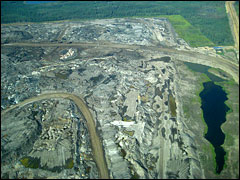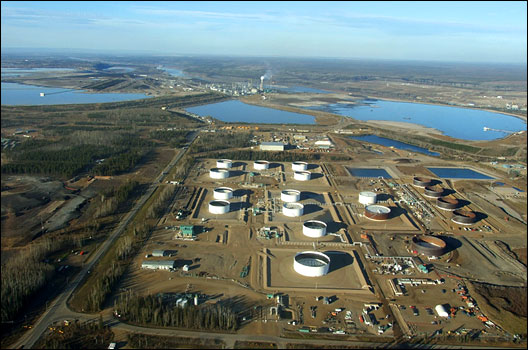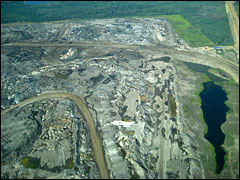What could beat Amazonian deforestation, massive coal plants next to elementary schools, factory farming, mountaintop removal, and giant trash heaps in the middle of the ocean for the title of “the most destructive project on Earth“? [PDF]
Cue the tar sands, a vast expanse of the Albertan province opened up to rampant drilling, surface mining, and pipelines through what was once a strikingly beautiful section of the Canadian boreal forest. Canada’s Environmental Defense deemed it “the most destructive project on Earth” last February.
While this region holds immense ecological and aesthetic value on the planetary exterior (it is the largest remaining unspoiled forest and wetland ecosystem and one of the most biodiverse carbon sinks on Earth), its subterranean layers are rich with oil that is deeply embedded in an earth and sand mixture called bitumen. Starting to imagine what this project might look like?
Some have likened it to Mordor, the fictional land ravaged by the Dark Lord in the Lord of the Rings trilogy. Huge swathes of forest — the tar sands developments are visible from space — have been leveled to mine the earth, make way for processing facilities, and provide space for tailing ponds. The projects strain the freshwater capacity from the Athabasca River, and the downstream pollution is linked, some believe, to rising cancer rates in indigenous communities.
The world’s leading oil and gas companies are salivating over Alberta’s tar sands, thanks to record oil prices for much of 2008 and declining access to the fossil fuel resources in countries like Russia and Venezuela. Alberta is estimated to be home to 60 percent of the world’s more easily accessed oil reserves.
The pipe dream of North American oil independence has spurred a gold rush to this fossil fuel playground. A who’s who of Western oil companies comprises the all-star lineup of tar sands players — Chevron, ConocoPhillips, Imperial Oil, Shell, BP, Syncrude, Statoil, PetroCanada, and more. Unfortunately, tar sands drilling and mining has only just begun. Companies plan to spend as much as $125 billion to expand mining, drilling, and refining operations over the next 10 to 15 years. And neither the Canadian federal nor provincial governments have stepped up to the challenge of planning for the cumulative impact of all the development.
Alongside environmental watchdogs, shareholders are raising red flags and demanding that drillers move slowly and cautiously. In the U.S., our firms, Green Century Capital Management and Trillium Asset Management Corporation, two socially responsible investment companies, have been mobilizing at Chevron and ConocoPhillips. The Canadian mutual funds company Ethical Funds has engaged a number of Canadian oil and gas firms and produced several useful reports on the tar sands. Investors in the U.K. and Europe have been approaching BP and Shell.
Green Century and Trillium filed shareholder resolutions in 2008 at Chevron and ConocoPhillips, outlining key risks and asking the companies to report on environmental damage resulting from their expanding tar sands operations, including the implications of discontinuing expansion plans.
Included in the laundry list of obvious risks to the companies, the investors noted impending costly regulations on carbon emissions in both Canada and the U.S. (the tar sands’ largest customer); declining operational water availability; reputational damage due to impact on air quality, water quality, and wildlife; and the possibility of litigative and competitive threat.
In making our case to our fellow shareholders, Green Century and Trillium noted the particularly worrisome hazard surrounding tailing ponds from mining operations, acutely toxic pools of sludge that cover almost 20 square miles of forest and bogs. Last year, these nasty puddles were splashed across international headlines when an entire flock of 500 migrating ducks was found dead in one of Syncrude’s massive tailing ponds.
Nearly 30 percent of both companies’ shareholders supported the proposals presented by Green Century and Trillium. This is a very high vote in the rarefied world of shareholder proposals — not quite a vote of no confidence, but a strong signal to executives that a critical minority of stockowners is not on board with the program.
Green Century and Trillium are now pursuing follow-up meetings with both companies to discuss last year’s resolutions and the companies’ plans to address investor concerns.
In the end, the tar sands are a textbook example of our failure as human beings to look beyond short-term profit maximization. In a rational global economy capable of looking to long-term rewards, we would now be enjoying the economic, political, and environmental benefits of two decades of aggressive efficiency measures, phased-down fossil-fuel use, and the mass distribution of renewable energy technologies.
Instead, we have new financial maelstroms threatening our economy every week, the “most destructive project on Earth” annihilating one of our planet’s most valuable ecological resources, and … hundreds of unnecessarily dead ducks.




